‘Halloween Kills’ (2021) Explained and Analyzed
Halloween Kills continues the story of Michael Myers and Laurie Strode with increased violence and a higher body count. Here is what happens in the film and what it all means.
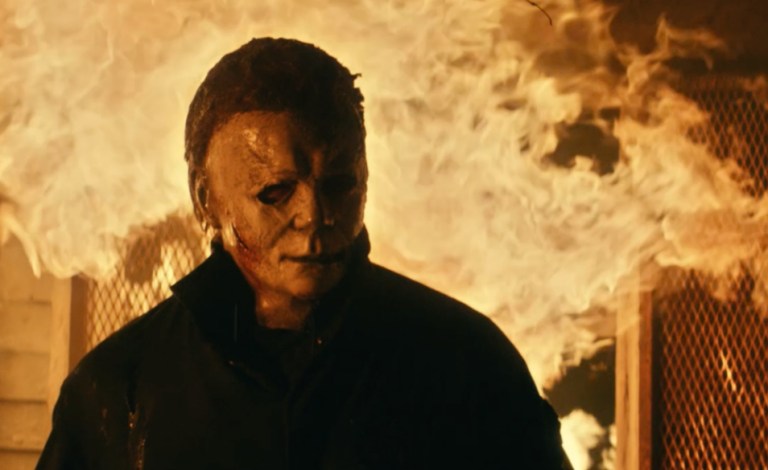
Table of Contents
Michael Myers comes home to theaters once again with a continuing night of bloody terror in Halloween Kills. The film was one of the most anticipated movies of the 2021 Halloween season, but was it worth the wait? Read on for a full breakdown of Halloween Kills.
Background
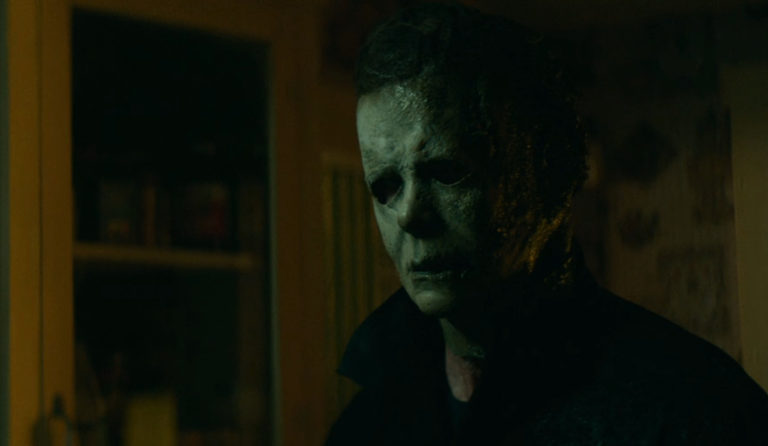
Halloween Kills is the twelfth installment of the long-running Halloween franchise. It is a direct sequel to Halloween (2018), taking place immediately after the previous film. The Halloween franchise has multiple branching timelines, so the only movies you’ll need to watch to get caught up for Halloween Kills are Halloween (1978) and Halloween (2018). So technically, Halloween Kills is only the third film in the story, and no other movie in the franchise outside of those three exists within its continuity.
Halloween Kills is directed by David Gordon Green, who also directed Halloween (2018). David Gordon Green and Danny McBride both wrote this film and the 2018 Halloween, and they were joined on Halloween Kills by co-writer Scott Teems. The film is produced by, among others, Malek Akkad (son of Moustapha Akkad, the former executive producer of the Halloween franchise), Jason Blum of Blumhouse Productions, and Bill Block.
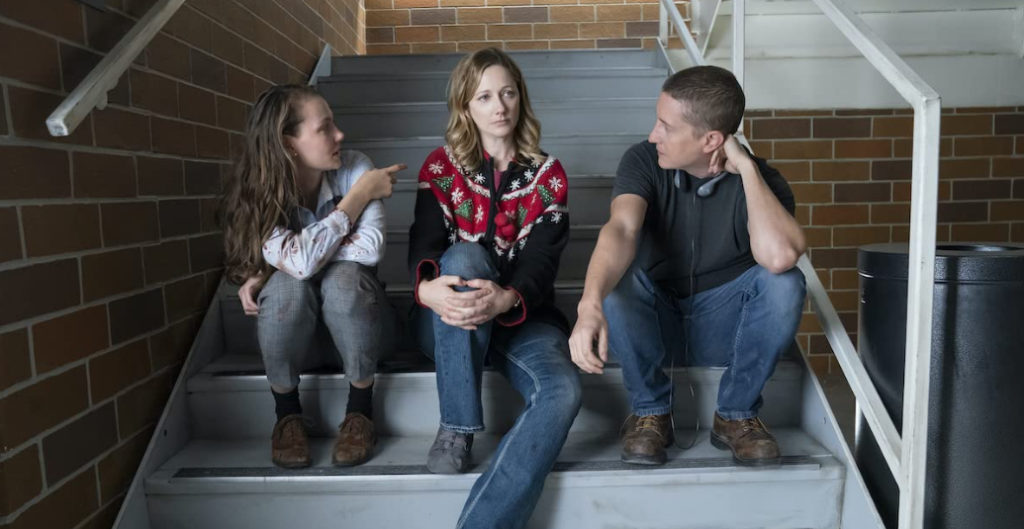
Halloween Kills was originally announced to be in development along with the next film in the series, Halloween Ends, in 2018 after the successful release of Halloween (2018). Filming for Halloween Kills took place in late 2019 with an original release date of October 2020, but the COVID-19 pandemic pushed the release back to October 15, 2021. The film was released simultaneously in theaters and on the Peacock streaming service.
Review
So the big question: Is Halloween Kills any good? Well, it depends on who you ask. As of the day of its release, Rotten Tomatoes was divided with a “rotten” score of 44% from critics and a “fresh” score of 77% from viewers. To answer the question though, yes, Halloween Kills is an entertaining slasher movie with strong bloody violence and an interesting take on the continuing saga of Michael and Laurie.

Though there are a few flashbacks, the bulk of Halloween Kills takes place on the same night as Halloween (2018). Michael Myers escapes the trap set by Laurie Strode at the end of that film, and he continues his night of murder. Meanwhile, when Michael’s actions become public knowledge, the people of Haddonfield rally behind a survivor of the 1978 attacks, Tommy Doyle, to hunt Michael down. The film follows Laurie, her daughter Karen, her granddaughter Allyson, and Tommy as they each take different approaches to dealing with Michael.
One of the most interesting aspects of Halloween Kills is that it drastically reduces Laurie’s impact on the plot. Instead of focusing primarily on Laurie, the movie splits its focus towards a larger group of characters. That’s not to say Laurie is irrelevant. On the contrary, Laurie’s character arc is probably bigger in Halloween Kills than it is in Halloween. It’s just her physical role in affecting the action that is almost non-existent, but that plays directly into the themes of the film (more on that in a later section).
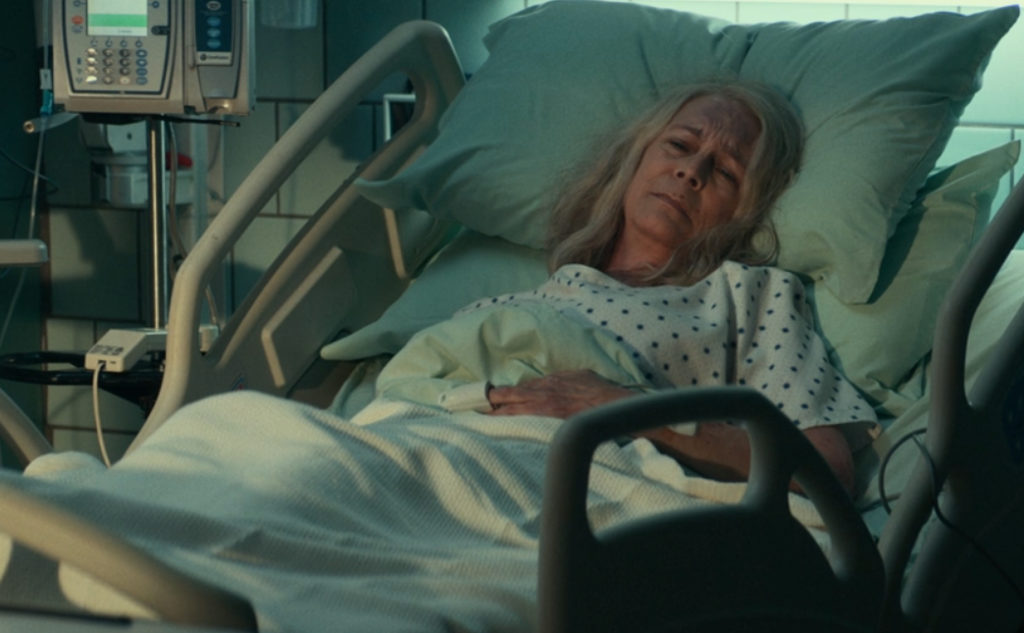
Halloween Kills manages to bring a lot of meaning to the events that transpired in previous films. Since it takes place on the same night as the 2018 film, many of that movie’s victims are just now being discovered by friends and family. Viewers see the trauma these deaths bring, when in the previous film they might have just been fun murder scenes that didn’t mean much to us. Trauma plays a large role in Halloween (2018) as well, but now it’s not just limited to Laurie. It includes everyone, and the effects of individual and collective trauma are at the forefront of Halloween Kills.
As a sequel, Halloween Kills does follow some well-worn territory about what has come to be expected from a horror sequel. The kills are much more numerous and violent, and, with a few exceptions, a good portion of the deaths don’t have much emotional weight. Many characters are introduced briefly only to be slaughtered, or they’re not even introduced at all before being killed off. Of course, whether this is good or bad depends on what you’re looking for in a slasher movie. Judged against the original Halloween from 1978 it feels odd, but judged against the 2018 film it feels like a natural progression.
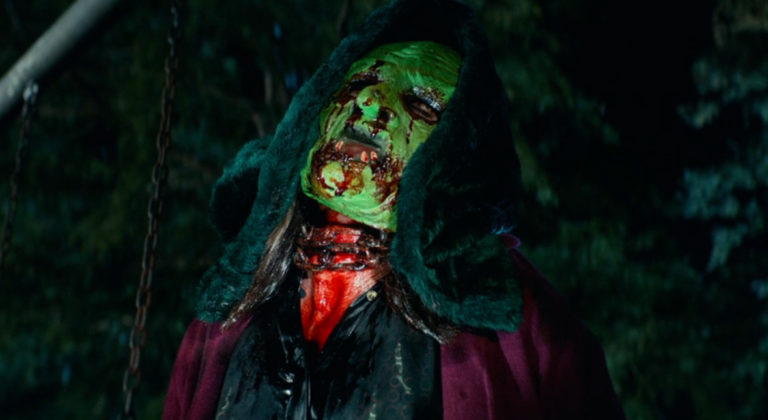
Halloween Kills also takes Michael Myers in a direction some viewers may not be too interested in. The Boogeyman aspect of Michael is heavily reinforced in this movie, but it doesn’t do it in a way that feels like the 1978 film. The themes can come across as heavy-handed in Halloween Kills, while there is much more subtlety in John Carpenter’s approach.
Overall though, Halloween Kills is big, violent fun with tons of callbacks for fans of the Halloween movies. It drifts far from the original film from 1978 and even from the 2018 sequel, but it’s still a good and gory time.
Plot Summary
Warning: There are major spoilers throughout the rest of this article.
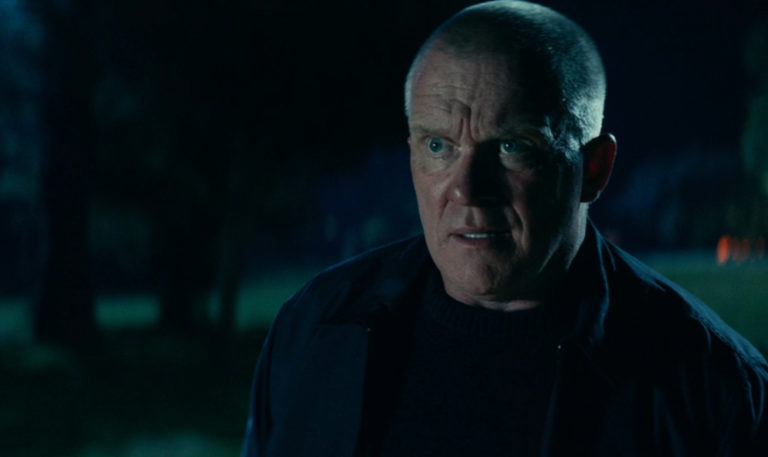
As stated above, Michael escapes Laurie’s trap from Halloween (2018). Near the beginning of Halloween Kills, we see Laurie and her family being driven away from her burning house as fire trucks pass in the opposite direction. Laurie is taken to Haddonfield Memorial Hospital while firefighters deal with the blaze. The floor of the house collapses, creating an escape route for Michael who was hiding from the flames in Laurie’s basement behind a metal door. Michael brutally slaughters all of the firemen inside and outside the house, and he walks away with a destination left ambiguous until later in the film.
Meanwhile, Tommy Doyle and fellow survivors from 1978 including Lindsey Wallace, nurse Marion Chambers, and Lonnie Elam (who is shown in a flashback to have encountered Michael face to face) are gathered to remember the attacks from forty years prior. Tommy is clearly still affected by the night of terror, and when he sees news footage of a new set of murders, he quickly becomes determined to end Michael’s life. Tommy gathers a group of similarly minded people to track Michael down.

With Laurie and her family in the hospital and Tommy and his crew splitting up to comb the streets, Michael is seen making his way through Haddonfield, murdering people along the way. A group of would-be vigilantes encounters Michael, and most of them are killed. Lindsey is part of the group, but she survives by hiding as Michael continues his journey. Tommy arrives later, taking Lindsey to the hospital. Karen and Laurie believe Michael will show up at the hospital to kill Laurie, so Tommy gets everyone ready for a confrontation. The group of citizens at the hospital is brought to such a rage, that they attempt to lynch an inmate who also escaped from the bus that Michael was on in Halloween (2018).
Out in the streets, Allyson has gone with Lonnie and Lonnie’s son (who is Allyson’s boyfriend from the previous film) to continue their search for Michael. Tracking Michael’s attacks throughout the night, Lonnie realizes that Michael is heading towards his childhood home. The three of them go to the old Myer’s place, now occupied by a couple who become unfortunate victims. At the hospital, Laurie and Karen realize that Michael isn’t after Laurie at all. He was always just trying to get back home, and his murderous fixations don’t seem to have any deep significance. Karen rushes to the Myers house, arriving just in time to save her daughter.
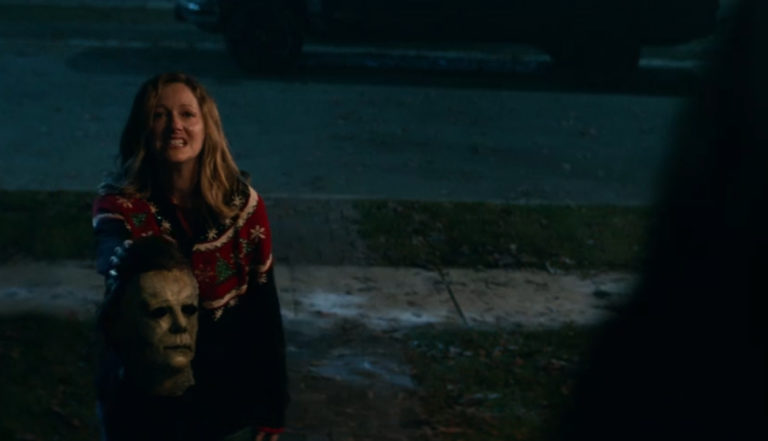
Karen gets Michael to follow her, leading Michael into a trap where he is surrounded by Tommy and his lynch mob. Michael is shot and beaten, and it looks like he is finished for good. When Karen goes away to check on Allyson, Michael gets up and kills what appears to be everyone around him, including Tommy and Leigh Brackett (the returning Charles Cyphers). Karen, still thinking Michael is dealt with, goes into the Myers house to reflect on what she’s learned about Michael and about herself tonight. While Karen stands inside Michael’s sister’s former room, Michael appears behind Karen, killing her. The movie ends with Michael looking out of the window of his house as Laurie stands alone in the hospital.
A Brief Analysis
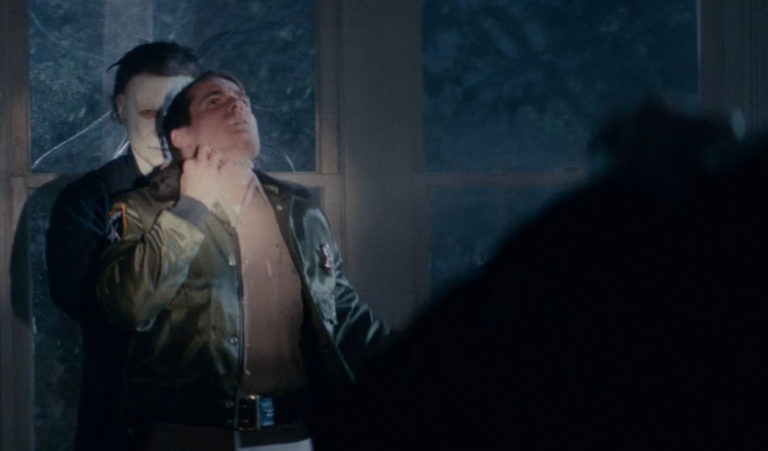
While Halloween (2018) was largely about Laurie’s individual trauma, Halloween Kills is more about collective trauma. Tommy Doyle is shown near the beginning of the film as someone who still hasn’t gotten over his encounter with Michael Myers in 1978. He hasn’t let it consume him like Laurie did, but he is still feeling the effects. In a way, Tommy is a strong representation of the town of Haddonfield. Though younger generations don’t know or don’t care about the town’s dark past, there is a lingering fear bubbling just under the surface for everyone else. It doesn’t take much for Tommy to turn that fear into anger when he rallies everyone to hunt and kill Michael. The lingering effects of 1978 still echo throughout the town.
The mob mentality of the people of Haddonfield is almost as frightening as Michael Myers himself. Myers is portrayed as a force of nature, an unstoppable monster. Though there is speculation in the film, no one really knows why he kills. On the other hand, the people of Haddonfield should know better than to act the way they do. The townsfolk scream for blood, and they get it when their bloodlust causes a second escaped inmate to run in fear and ultimately kill himself in an attempt to get away.
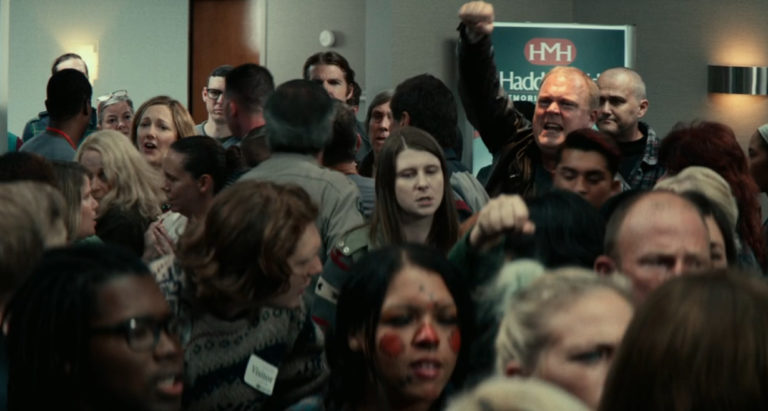
Laurie sees the mob firsthand, and in them she sees her own fears reflected. Laurie is broken down in Halloween Kills, and seeing the mob kill a man is part of that process. Laurie spent the majority of her life preparing to kill Michael. She was sure she was Michael’s ultimate target, and she spent her life preparing. Her lifestyle pushed away her family and made her the crazy lady on the edge of town in the eyes of Haddonfield’s residents. She was sure of herself though, and that’s what allowed her to carry on.
When Laurie realizes that all of her planning failed to kill Michael, it renews her anger. Was everything she did pointless? She is ready to fight again, but her body (and stab wounds) won’t allow her to. The final act in the breakdown of Laurie’s previous character is when she realizes that Michael never planned to come back for her at all. Michael was just trying to get home, and, in 1978, Laurie happened to be in the wrong place at the wrong time. The story that Officer Hawkins shares when he blames himself for letting Michael continue his killing helps Laurie realize that she was doing the same thing. She was putting the weight of Michael’s deeds on herself when there was no reason to. It’s in that moment that she realizes Michael’s actions reach far beyond herself. He has affected the entire town.
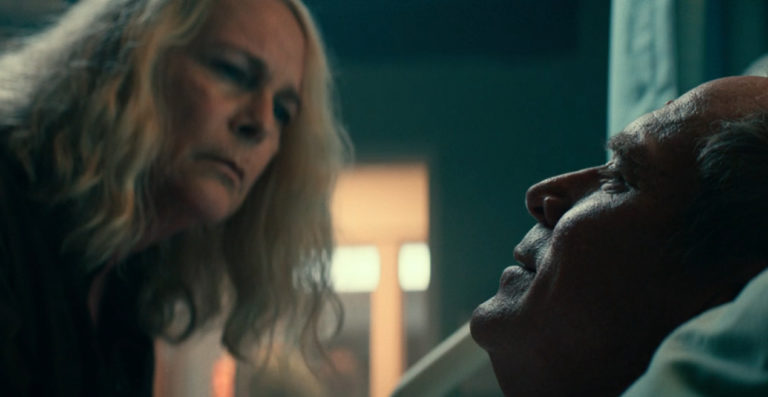
The sense that Michael has infected everyone with fear is what points to Michael once again being portrayed as the Boogeyman. The finale of Halloween (1978), when Michael disappears after being shot by Loomis, emphasized Michael’s almost mystical presence as an embodiment of fear. In Halloween Kills, the idea of Michael being more than a man is shown throughout the film by his superhuman ability to avoid death. Right at the beginning of the movie, he emerges from the metaphorical fires of Hell to single-handedly take out an entire group of firemen who are armed with axes and saws. Then at the end of the movie, he stands up and continues fighting after being shot in the chest multiple times in addition to being beaten. While Michael’s status as just a man could be argued in the 2018 Halloween, Halloween Kills portrays him as something else entirely.
Michael as the Boogeyman is reinforced in multiple ways. He’s not only invincible, but he’s also unknowable. He is not after Laurie in this film, so what does he want? It’s safe to assume he wants to go home, but why? What is he thinking about? His sister Judith? Maybe, but no one knows. Michael’s face is also left mostly unseen. The characters in the movie see his face on television and when Karen unmasks him late in the film, but for the audience, his face is either out of focus or seen only in quick glimpses. His burns from the fire further obscure his features. With unknown motivations and a largely unknown identity, Michael serves as a conduit for the fear of the unknown. Fear is an internal struggle, not an external one, and that is why Michael keeps getting up time and time again.

Ultimately, even with everything new it tries to bring to the series, Halloween Kills is at its best when reinforcing ideas present in John Carpenter’s Halloween. Michael Myers is the Boogeyman who has no discernable motive for what he does as an unstoppable killer. The world is a scary place, and it’s rarely ever reasonable. Reacting out of fear isn’t the answer though, and that’s the hard lesson the people of Haddonfield learn in Halloween Kills. For many of them, that realization came too late.
